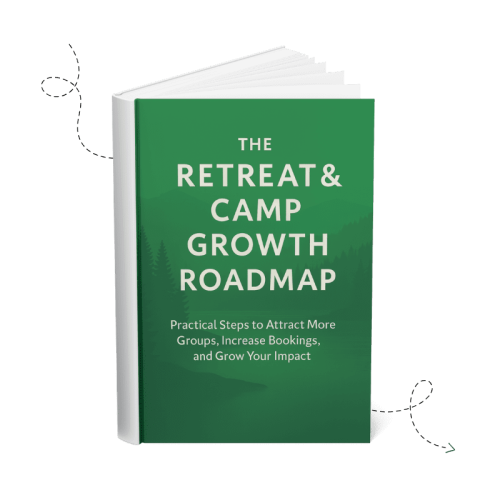Retreat & Camp Growth Roadmap Step 5: Develop Organic Traffic
Organic traffic is one of the most valuable sources of new group inquiries for retreat centers and camps—but it takes an intentional strategy to develop. In this step of the Retreat & Camp Growth Roadmap, we explore how to build a consistent stream of qualified visitors through content optimization, blogging, and ongoing SEO improvements.
When done well, this approach doesn’t just improve visibility in search engines—it helps build trust with both search engines and potential guests. It allows your retreat center or camp to show up in the moments when people are actively looking for what you offer, helping you connect with the right people at the right time.
Why This Step Matters
Many retreat centers and camps are overly reliant on word-of-mouth, returning guests, or paid ads to fill their calendars. While those channels are important, they don’t provide the consistency or scalability needed for sustainable growth.
Organic search traffic, on the other hand, can:
- Reach people who are actively looking for retreat experiences like yours
- Build credibility through helpful, relevant content
- Reduce dependence on paid channels
- Support long-term visibility and engagement
- Compound in value over time, like interest—building momentum the longer you invest
By showing up in search results when someone is seeking rest, renewal, or connection, you’re not just improving your metrics—you’re meeting people in a moment of need and helping them take the next step in their journey.
Investing in organic traffic isn’t just about getting more website visitors—it’s about creating an inbound lead system rooted in clarity, consistency, and stewardship.
Is This a Focus Area You Need to Work On Now?
Ask yourself the following:
- Do most of our website visitors find us by typing our name, rather than searching for retreat-related keywords?
- Is our blog inactive, outdated, or missing entirely?
- Do we lack clear, keyword-targeted pages for the types of groups we serve?
- Have we gone more than 6 months without auditing or improving our website content?
- Are we seeing fewer than 10 qualified inquiries per month from organic search?
If you answered “yes” to any of these, focusing on organic traffic can help you build a stronger, more reliable path for outreach.
Putting This Step into Practice
The “Develop Organic Traffic” step includes three interconnected focus areas. Each plays a key role in helping your retreat center or camp get found online, answer the right questions, and turn searchers into serious leads.
If this all sounds overwhelming, you’re not alone. Most retreat centers we work with start with just one of these areas and build from there. The important thing is to take the next faithful step.
Focus Area #1: Optimize Website Content
Before creating new content, it’s wise to strengthen what you already have. Most retreat centers and camps already have some form of website content—but it’s often outdated, too brief, or not optimized for search.
This focus area prioritizes making the most of existing content. That may include optimizing landing pages for group types (if you have them), updating general retreat descriptions, or improving your homepage messaging. Group landing pages are especially valuable for SEO and conversions, but not all organizations have them yet—and that’s okay. The idea is to start where you are and improve what you can.
Optimization includes:
- Clarifying who your content is for and how your retreat meets their needs
- Using keywords that align with what your audience is searching for
- Improving page structure, internal linking, and calls-to-action to increase engagement
The full article dives into the most common content gaps we see, how to spot them on your own site, and the specific changes that make the biggest impact in both search visibility and guest engagement. If you’ve ever wondered why your site isn’t generating more inquiries, this article offers practical clarity.
The companion worksheet is designed to help you assess and enhance your top pages step-by-step. Use it to pinpoint weak spots, brainstorm SEO improvements, and track your progress as you go.
🔗 Read the Full Article: Turn the Website Content You Already Have Into an SEO Magnet for Retreat Groups
📥 Download the Optimize Website Content Worksheet

Focus Area #2: Develop Blog Content
Blogging is one of the best ways to increase your visibility in search engines, especially for long-tail keywords that reflect specific questions, needs, or interests.
But the key to success isn’t just writing more—it’s writing with purpose. In this focus area, we explore how to:
- Identify blog topics your target audience is actively searching for
- Write content that balances inspiration with practical insight
- Use blogging to support both SEO and guest decision-making
In the full article, we break down how to find blog ideas your ideal guests are already searching for, how to outline posts that perform well in Google, and how to write in a way that builds trust while still staying mission-aligned.
The included worksheet walks you through a proven blog content planning process—from keyword research to topic selection to scheduling. It’s a great tool if you want to start blogging consistently but need help creating a manageable plan.
🔗 Read the Full Article: How Retreat Centers Can Use Blog Content to Build Visibility, Trust, and Lasting Impact
📥 Download the Blog Content Planning Worksheet

Focus Area #3: Execute On-site SEO Campaign
SEO isn’t a one-time project. It requires ongoing attention, testing, and refinement. Once your key pages and blog are in place, the next step is to implement a recurring SEO routine.
This focus area focuses on establishing a system for:
- Performing regular SEO audits to uncover issues or opportunities
- Updating content to reflect current best practices
- Tracking performance and making data-informed adjustments
The article goes deeper into what a healthy on-site SEO rhythm looks like—including the tools we use, common fixes that make a big difference, and how to prioritize updates when your time is limited.
The checklist is a simple but powerful guide for running your own SEO reviews on a quarterly or biannual basis. It helps you catch technical issues, refresh outdated content, and stay proactive with your site’s performance.
🔗 Read the Full Article: How Retreat Centers and Camps Can Keep Growing With On-site SEO
📥 Download the On-site SEO Checklist

Mini Case Study
Black Rock Retreat Reclaims Growth with a Focused SEO Strategy
Black Rock Retreat, a Christian camp and retreat center in Pennsylvania, was facing a troubling decline in retreat bookings—their primary revenue source. Their existing website lacked SEO capabilities and made content updates nearly impossible. Despite a strong reputation and active Google Grant ads, their visibility and conversion tracking were falling short.
Partnering with Improve & Grow, they began by optimizing the content on their existing website. Updates to page copy, structure, and metadata helped their group offerings rank more effectively in search engines. As on-site SEO improvements were implemented over time—including internal linking, updated calls-to-action, and keyword targeting—both traffic and inquiries steadily increased.
These gains from content optimization and SEO helped generate the momentum and confidence needed to invest in a new, fully optimized WordPress website. The new site offered a cleaner structure, better performance, and mobile responsiveness—all critical to maintaining and accelerating growth. It also gave their team the tools to add landing pages, publish blogs, and make ongoing updates.
With a firm foundation in place and a clear strategy for growth, Black Rock Retreat continued executing on-site SEO efforts and expanding optimized content. Over three years, retreat-related traffic more than doubled and inquiries increased by over 600%.
Putting It All Together
Building organic traffic is one of the most effective long-term marketing strategies for retreat centers and camps. When you:
- Strengthen the website content you already have
- Create strategic blog content that builds visibility and trust
- Run an ongoing SEO improvement process
you can attract more mission-aligned guests, reduce your dependence on paid ads, and create a more stable, sustainable lead flow.
Here are five practical next steps you can take:
- Audit your current website content for clarity, relevance, and SEO readiness.
- Brainstorm blog topics based on the questions guests ask most often.
- Schedule your first SEO audit to check for gaps or issues.
- Build a simple content calendar for quarterly updates.
- Commit to tracking your organic traffic and inquiries each month.
Even small steps in each of these areas can create momentum. Choose one area to focus on first, take action consistently, and build on your progress. Over time, these habits will strengthen your visibility, grow your reach, and help your ministry thrive.
Ready to Take the Next Step?
Want to build a lead engine that grows your reach and your impact?
If you found this helpful, here are four great next steps to continue your journey:
🧭 Move to the Next Step: Strengthen Booking Process
Create a system that ensures no lead gets lost and every qualified group gets timely follow-up.
[Read the Strengthen Booking Process Focus Area Article]
📘 Download the Retreat & Camp Growth Roadmap eBook
Get the full 3-stage system we use to help retreat centers and camps grow with clarity and purpose.
[Download the eBook]
🌱 Learn More About How We Help Retreat Centers & Camps
We’re a Christian-owned digital marketing agency that helps retreat centers and camps grow attendance, bookings, and impact through practical strategies rooted in clarity and stewardship.
[See How We Can Help]
🤝 Schedule a Free Discovery Call
Want help applying this to your unique situation? Let’s talk. We’ll explore where you are now, where you want to go, and how to take the next faithful step.
[Book a Discovery Call]
You don’t have to figure this out alone. Let’s build something meaningful—together.
Frequently Asked Questions
How long does it take to see results from SEO?
SEO is a long-term strategy designed to produce lasting results. Most retreat centers start seeing early improvements within 3–6 months—such as increased traffic or better keyword rankings. Significant gains in leads and inquiries often emerge within 12–18 months with consistent effort.
Can we do this with a small team?
Yes, many retreat centers make steady progress with just one or two committed team members. The key is to break tasks into manageable steps. You can also collaborate with a retreat center marketing agency to handle the more technical or time-intensive aspects.
What if we don’t have a blog yet?
That’s okay—many retreat centers start from scratch. Begin by answering common questions your guests ask or telling stories that reflect your mission. Even one or two well-optimized posts can help boost visibility and engagement.
How do I know which keywords to use?
Focus on phrases your ideal guests might use when searching, such as “Christian women’s retreat in [your state]” or “summer camp near [city].” Free tools like Google Keyword Planner or paid platforms like SEMrush can help you identify opportunities. Or, consult with camp marketing agencies that specialize in SEO for retreat centers.
Do we need to hire an SEO expert?
Not necessarily. If someone on your team is willing to learn, you can implement a lot on your own using tools and checklists. However, partnering with a Christian camp SEO expert can shorten the learning curve and help you avoid costly mistakes.
What’s the difference between on-site and off-site SEO?
On-site SEO involves everything you control on your website—like content, titles, internal links, and load speed. Off-site SEO focuses on gaining credibility from external sources, such as backlinks, local listings, and social signals. This step emphasizes building a strong on-site foundation first.
Will this help our summer camp programs too?
Absolutely. The same principles apply whether you’re promoting retreats, summer camps, or other programs. Improving your search presence often boosts awareness for all offerings, especially if you create optimized pages for each.
How often should we update our content?
Plan to review and refresh your top-performing or mission-critical pages every 6–12 months. This keeps information current and allows you to improve keyword usage, structure, or engagement elements as trends shift.
What if our website isn’t built for SEO?
If your site is difficult to update or lacks key SEO features, it might be time for a website upgrade. A modern, mobile-friendly WordPress site gives you flexibility, control, and a solid platform for growth.
Where should we start if we can only do one thing?
Focus on optimizing your most important retreat landing page. Make sure it’s clear who it’s for, what you offer, and how people can take the next step. This is often the fastest path to better visibility and more inquiries.
What if we don’t have the capacity to do all this right now?
That’s completely understandable. Most retreat centers have limited staff and wear many hats. Start with what you can manage—perhaps optimizing one key page or writing one blog per quarter. Small, consistent steps can still yield meaningful results over time, and you can build from there as capacity grows.





